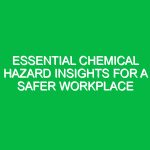Welcome team,
Today, we are here to discuss an essential aspect of our work – Dealing with Hazards within the Health, Safety, and Environment (HSE) domain. This Toolbox Talk aims to equip you with the knowledge and skills to navigate potential risks effectively, ensuring a safe working environment for all. Let’s dive into the topic and explore the best practices for managing hazards in our daily operations.
The Importance of Dealing with Hazards
Dealing with Hazards is a crucial part of our daily routines. By identifying, assessing, and managing hazards proactively, we can prevent accidents, injuries, and environmental harm. Each one of us plays a vital role in maintaining a safe workplace, and understanding how to deal with hazards is key to achieving this goal.
Key Aspects of Dealing with Hazards in the HSE Domain
When it comes to Dealing with Hazards, there are several key aspects to consider:
- Risk Assessment: It’s essential to assess potential hazards in our work environment regularly.
- Hazard Identification: Recognizing different types of hazards, whether they are physical, chemical, biological, or ergonomic.
- Control Measures: Implementing controls to mitigate risks and prevent accidents.
- Emergency Response: Knowing how to respond in case of emergencies related to hazards.
Potential Hazards and Risks
Some common hazards we may encounter include slips, trips, falls, exposure to hazardous substances, electrical hazards, and more. It’s crucial to be aware of these risks and take necessary precautions to avoid incidents.
Best Practices for Dealing with Hazards
Here are some best practices to follow when dealing with hazards:
- Stay Vigilant: Continuously scan your surroundings for potential hazards.
- Report Hazards: If you identify a hazard, report it to your supervisor immediately.
- Use Personal Protective Equipment (PPE): Wear appropriate PPE to protect yourself from potential risks.
- Follow Procedures: Adhere to safety procedures and guidelines at all times.
Real-Life Examples
Let’s consider a scenario where a spill occurs in the workplace. How would you deal with this hazard? By promptly cleaning up the spill and placing warning signs, you can prevent slips and falls, ensuring a safe environment for everyone.
Regulations and Standards
It’s essential to be familiar with relevant regulations, such as the Occupational Safety and Health Administration (OSHA) standards, as well as company policies regarding hazard management. Compliance with these regulations is crucial for maintaining a safe work environment and meeting legal obligations.
Conclusion
Today, we have discussed the importance of Dealing with Hazards in the HSE domain. By being proactive in identifying and managing hazards, we can create a safer workplace for all. Remember to apply the best practices we’ve discussed in your daily operations. Thank you for your attention and commitment to safety.


